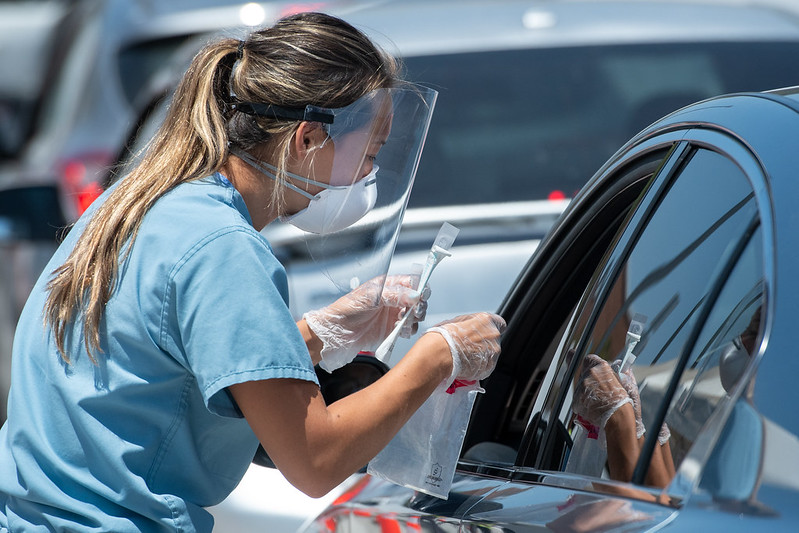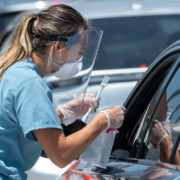
SOME 320 days have passed since the first reported case of the COVID-19 in California was confirmed on Jan. 26.
Most people rebuffed the acuteness of the news, believing it to be another passing viral fancy that won’t reach critical levels, similar to the Ebola crisis of the previous decade.
Then, reports of hundreds of other confirmed cases surfaced, signaling California leadership to announce stay-at-home orders in mid-March that limited public mobility and spaces among residents to mitigate the virus’s spread. But even then, many people — including the president of the United States — believed the calamity would calm by Easter.
Today, nearly 11 months since the first case was reported in California, the state continues to break daily records of positive cases, deaths and dwindling hospital capacity: nowhere near calm. Los Angeles County continues to lead the state and the country in total number of positive coronavirus cases at 501,635 and 8,199 deaths to date. On Friday, December 11, officials reported a record number of 13,815 new cases, a day after adding 12,819.
“We’re on a very dangerous track to seeing unprecedented and catastrophic suffering and death here in LA County if we can’t stop the surge,” Public Health Director Barbara Ferrer said during her daily briefing on Friday. “I’m making a request to everyone to stay home.”
Nevertheless, the grim numbers haven’t curbed defiance of public health orders. Before LA County triggered the regional stay-at-home order, Old Town Pasadena experienced droves of restaurant patrons enjoying meals in close quarters and, often, maskless in resistance to the county’s shutdown of outdoor dining.
In Orange County — particularly the southern part of the county — residents have consistently ignored the public health crisis, holding protests that don’t comply with pandemic rules governing public gatherings and preaching about the alleged freedoms that are threatened by lockdown orders, orders that are designed to keep people safe.
All year, the Asian Journal has been reporting on the rollercoaster ride of economic re-openings and re-closings, spikes in positive cases of the virus and “comfortable” plateaus.
Among the latest of those reports detailed the regional stay-at-home order that directs groups of California counties to adhere to a new set of rules if hospitalization reaches below 15% capacity.
Business impact
There are valid reasons to be frustrated with the stay-at-home orders and the confusing messaging coming from state, county and city leadership, especially if you’re a business owner, so many of whom have dealt a hard economic blow.
“I feel so frustrated as this time of the year is when we can finally feel like we can recover and rebuild. The holiday season is our busiest and now being shut down is devastating for me and my team of hairstylists,” said Sherry Younge, a Los Angeles-based hair stylist and owner of The Artform Studio, a hair salon and record store hybrid business that she runs with her DJ/music producer husband Adrian Younge.
Younge, who is Filipina American, told the Asian Journal that she has made sure to follow public safety protocols at her studio, undergoing “extra precautions” like issuing questionnaires about any symptoms guests and stylists may have or if they’ve been in contact with a COVID-19-positive person. She’s also invested in placing barriers between styling stations “that are already 6 feet apart,” extra disinfecting supplies, and ensuring that all stylists and guests are wearing masks and temperature-checked.
After the second shutdown earlier this year, The Artform Studio (which doesn’t have salon employees but rather, contracted stylists) was able to work outdoors with 25% capacity that was then lowered to 20%.
But the recent regional stay-at-home order that was issued earlier this month prohibits all salon and barbershop operations, forcing salon owners like Younge to shut down for at least the next three weeks.
“I hope that the Governor [Gavin Newsom] and Mayor [Eric Garcetti of LA] see that our industry abides by safety measures and shutting us down will hurt small businesses that do not contribute to the rise in COVID-19 numbers,” Younge said, noting that her salon plans to offer curbside pick-ups for hair care, music records and books.
The frustration that Younge feels about the economic effect of the pandemic is coupled with her equal frustration and concern over the rising coronavirus numbers in the region.
Younge said that she had two family members pass from COVID-19, and the uncertainty of the economic future has made her, her team of stylists and their clients “uneasy.”
The rising numbers may be a product of what has been known as COVID-19 fatigue.
People are simply sick of the economic closures and have been taking advantage of whatever respite they can find, whether it’s visiting family for the holidays and finding a restaurant that offers dine-in services.
Last month, more than 3 million Americans flew through domestic airlines the weekend before Thanksgiving, according to the Transportation Security Administration (TSA). Families have been separated for so long and the holiday season, a traditionally family-heavy time of the year, is enough of a reason for people to seek out travel and break public safety protocol.
A daily risk
“People have COVID fatigue,” Dr. Jasmine Eugenio, a Filipina American pediatrics specialist at Martin Luther King, Jr. Outpatient Center in Los Angeles, told the Asian Journal in an interview on Thursday, Dec. 3. “There is a large amount of people who are using masks already, but maybe it’s them getting careless and they’re tired of staying home.”
But the rapid increase in hospital admissions due to the virus serves as a disturbing reminder of the effects of ignoring safety precautions. As of press time, ICU capacity across the state of California has risen 70% in only two weeks, leaving less than 10% of beds available across the state.
In LA County alone, about 3,300 people are currently hospitalized for COVID-19, a profound finding that could mean that future patients may not receive the care they need.
“The worst case is if you are sick in the hospital and you need a ventilator, those are very hard — there are only so many ICU and ventilation units available for LA County. They are predicting that in the next four weeks, if we do not hunker down and do what we’re supposed to, there will definitely be a lack of beds and also staffing because we are stretched as staff become affected themselves,” Eugenio said, anticipating an influx of patients as the holiday season commences.
Christmas is an important family holiday, especially for Filipinos. There are more than 606,000 Filipinos in Southern California, and in LA County alone (which is home to about half of all SoCal Filipinos). But, 1 in every 200 county residents is infectious, prompting concern over the expected impact of COVID-19 on the community after the holiday season.
“Because there are a lot of people who I’ve seen have tested positive but are not symptomatic, it’s hard to say, but it’s taking a risk every time you go out. You don’t know, but the chances are very high because it’s out there and it’s raging,” Eugenio said.
She added that the yearly flu season can and will complicate things if you’re also exposed to the coronavirus, saying that “the flu virus can aggravate COVID. You can get both and each one of those viruses can make the other worse. Once we have access to the COVID vaccine, it’s important to get that as well.”
“No matter how much we emphasize the fact that you should stay in your households, especially for Filipinos, they think that [their] household includes lolo and lola, even if they live across the street. Or their cousins who don’t live with them, so they think it’s acceptable to get together for the holidays because they’re family, even if it’s downscaled because we are used to large amounts, like 30-40 people, at a time,” she said.
Before planning to travel for the holidays, Eugenio warns Filipinos that celebrating with people who don’t live in your household could pose a danger to those you live with who may be more vulnerable to the virus. Although it’s not the ideal way to celebrate Christmas, hosting virtual celebrations with family may be the safest option.
“They say Christmas only comes once a year, but there will be other Christmases,” Eugenio remarked.






